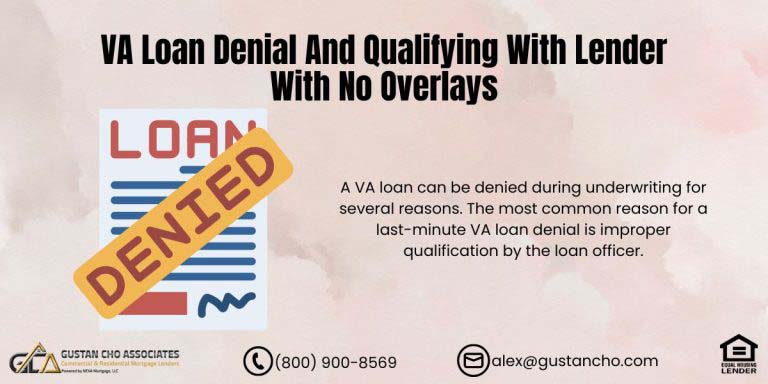This Article Is About FHA Investor Overlays Versus HUD Agency Mortgage Guidelines:
It is very important to understand the difference between HUD agency guidelines versus lender overlays. HUD is the parent of FHA. Every lender requires borrowers to meet the minimum HUD agency guidelines. However, lenders can have higher lending guidelines and standards that are above and beyond the minimum HUD agency lending guidelines. This higher lending requirement by mortgage companies is called lender overlays. Each lender can have its own lender overlays. Some lenders have higher lender overlays than others. Gustan Cho Associates does not have any lender overlays on government and FHA loans.
Over 75% of our borrowers at Gustan Cho Associates are folks who could not qualify at other mortgage companies due to its lender overlays. In this article, we will discuss FHA investor overlays versus HUD agency mortgage guidelines.
Government Loans Explained
FHA loans are one of three government-backed home loans. The three government loans are FHA, VA, USDA loans. Government-backed home mortgages are for primary owner-occupant loans. Private lenders originate and fund government loans. Government agencies backing the government home loans will insure and/or partially guarantee lenders in the event homeowners default and/or foreclosure on the government-backed loan.
Lenders offer little to no down payment with lenient agency mortgage guidelines at low mortgage rates on government-backed loans due to the government guarantee. FHA loans by far are the most popular government-backed loan program in the nation. Every hard-working American homebuyer can be eligible qualify for an FHA loan. However, there are restrictions on who can qualify for VA and/or USDA loans.
You need to be an active and/or retired member of the U.S. Armed Services with a valid certificate of eligibility (COE) to be eligible to qualify for VA loans. Not everyone can qualify for VA loans. To qualify for USDA loans, the property needs to be in a USDA-approved eligible area. USDA also has maximum income caps on household income for borrowers of USDA loans.
Conventional loans are not backed by any government agency. Conventional loans are private loans originated and funded by private lenders with no government guarantee.
Since FHA loans are the most popular home mortgage program in the U.S., in this blog we will target and narrow our discussion to lender overlays on FHA loans.
Government Versus Conventional Loans
Conventional loans are referred to as conforming loans because they need to conform to Fannie Mae and/or Freddie Mac Agency Guidelines. Fannie Mae and/or Freddie Mac will not purchase conventional loans that do not conform to their agency guidelines.
Lenders use their warehouse line of credit to fund conventional loans. Mortgage lenders need to sell conventional loans to fund on the secondary mortgage bond market in order to have the liquidity to repeat the loan origination and funding process. The role of Fannie Mae and Freddie Mac is to provide liquidity in the mortgage markets so lenders can originate and fund mortgages and stabilize the housing markets.
Mortgage companies need to all have their borrowers meet the minimum agency mortgage guidelines on government and conventional loans. However, lenders can have higher lending requirements than the minimum agency mortgage guidelines of FHA, VA, USDA, FANNIE MAE, FREDDIE MAC which are called lender overlays. Lenders can have lender overlays on just about anything and everything.
It is not illegal for lenders to require lending requirements that are above and beyond the minimum agency mortgage guidelines. Most lenders have lender overlays. This is why not every lender has the same mortgage lending requirements on FHA loans. Borrowers can meet all the minimum guidelines per HUD Agency Guidelines but be told they do not qualify with a particular lender.
There are lenders that have no lender overlays on FHA loans. If you are told you do not qualify for an FHA loan from one lender, go to a different lender that has no lender overlays. Gustan Cho Associates is one of the very few lenders with no lender overlays on government and conventional loans. We just go off the automated findings of the automated underwriting system (AUS) and have no additional lender overlays on FHA loans.
What Are Lender Overlays On FHA Loans
FHA Lender Overlays are additional lending guidelines that are imposed by individual lenders.
Lender overlays on FHA loans surpass the minimum HUD Agency Guidelines set by the United States Department of Housing and Urban Development (HUD). Just because a borrower meets the minimum HUD Agency Guidelines does not mean a lender will qualify, approve, and fund the FHA Loan. Lenders can have their own set of requirements called FHA Investor Overlays.
There are certain lenders such as Gustan Cho Associates that have no lender overlays on FHA loans. Gustan Cho Associates has ZERO FHA Investor Overlays. There are many types of FHA Investor Overlays a lender can impose.
In the following paragraphs, we will cover the most common FHA Investor Overlays that affect borrowers.
FHA Investor Overlays On Credit Scores
FHA Loans have minimum credit score requirements:
FHA Credit Score Requirements, you need a 580 credit score to qualify for a 3.5% down payment home purchase FHA loan. HUD allows borrowers with credit scores between 500 and 579 FICO to qualify for an FHA loan. However, a 10% down payment is required per HUD Agency Guidelines. These are the minimum credit scores required versus the down payment requirement by HUD to qualify for an FHA Loan. Lenders do not have to accept the minimum Credit Score Requirements and can have FHA Investor Overlays. Lender Overlays are higher standards than those of FHA Agency Guidelines.
Most lenders will have FHA Investor Overlays on credit scores where they will require a minimum credit score requirement of 640 FICO. Other lenders may take on a borrower with credit scores down to 620 FICO. Yet, a few lenders, like the investors I represent will not require any FHA Investor Overlays and will accept FHA mortgage borrowers with credit scores under 620 FICO Credit Scores. Those who are told that they do not qualify for an FHA loan because they do not have credit scores of 640 FICO by a particular lender may not qualify with that particular lender but can qualify for an FHA Loan with another lender with no FHA Investor Overlays.
If you are told that you do not qualify for an FHA Loan because your credit scores are not high enough, please contact us at Gustan Cho Associates at 800-900-8569 or email me at gcho@gustancho.com.
FHA Lender Overlays On Debt To Income Ratios
Another major reason why many borrowers do not qualify for FHA Loans is due to high debt to income ratios. FHA Guidelines On Debt To Income Ratios for 2020 is capped at 43% DTI if borrowers have credit scores below 620 FICO. The debt to income ratio requirements increases to 56.9% DTI back end and 46.9% DTI front end if the borrower has credit scores of 620 FICO or higher. However, most lenders have Overlays on debt to income ratios and may cap the debt to income ratios at 45%. Some lenders will go high as 50% debt to income ratios on the back end. If you are told that you do not qualify for an FHA Loan due to lender overlays on debt to income ratios, please contact us at Gustan Cho Associates at 800-900-8569 or text us for a faster response. Or email me at gcho@gustancho.com. Gustan Cho Associates is a national mortgage company with no Investor Overlays on FHA Loans. We just go by the minimum FHA Guidelines On Debt To Income Ratio Requirements.









